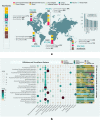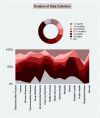Digital public health surveillance: a systematic scoping review
- PMID: 33658681
- PMCID: PMC7930261
- DOI: 10.1038/s41746-021-00407-6
Digital public health surveillance: a systematic scoping review
Abstract
The ubiquitous and openly accessible information produced by the public on the Internet has sparked an increasing interest in developing digital public health surveillance (DPHS) systems. We conducted a systematic scoping review in accordance with the PRISMA extension for scoping reviews to consolidate and characterize the existing research on DPHS and identify areas for further research. We used Natural Language Processing and content analysis to define the search strings and searched Global Health, Web of Science, PubMed, and Google Scholar from 2005 to January 2020 for peer-reviewed articles on DPHS, with extensive hand searching. Seven hundred fifty-five articles were included in this review. The studies were from 54 countries and utilized 26 digital platforms to study 208 sub-categories of 49 categories associated with 16 public health surveillance (PHS) themes. Most studies were conducted by researchers from the United States (56%, 426) and dominated by communicable diseases-related topics (25%, 187), followed by behavioural risk factors (17%, 131). While this review discusses the potentials of using Internet-based data as an affordable and instantaneous resource for DPHS, it highlights the paucity of longitudinal studies and the methodological and inherent practical limitations underpinning the successful implementation of a DPHS system. Little work studied Internet users' demographics when developing DPHS systems, and 39% (291) of studies did not stratify their results by geographic region. A clear methodology by which the results of DPHS can be linked to public health action has yet to be established, as only six (0.8%) studies deployed their system into a PHS context.
Conflict of interest statement
The authors declare no competing interests.
Figures








References
-
- Center, P. R. Internet/broadband fact sheet. https://www.pewresearch.org/internet/fact-sheet/social-media/ (2019). Accessed on July 2020.
-
- Index, G. W. Global Web Index’s Flagship Report on the Latest Trends in Social Media (GlobalWebIndex (GWI), New York City, 2018).
Publication types
LinkOut - more resources
Full Text Sources
Other Literature Sources

